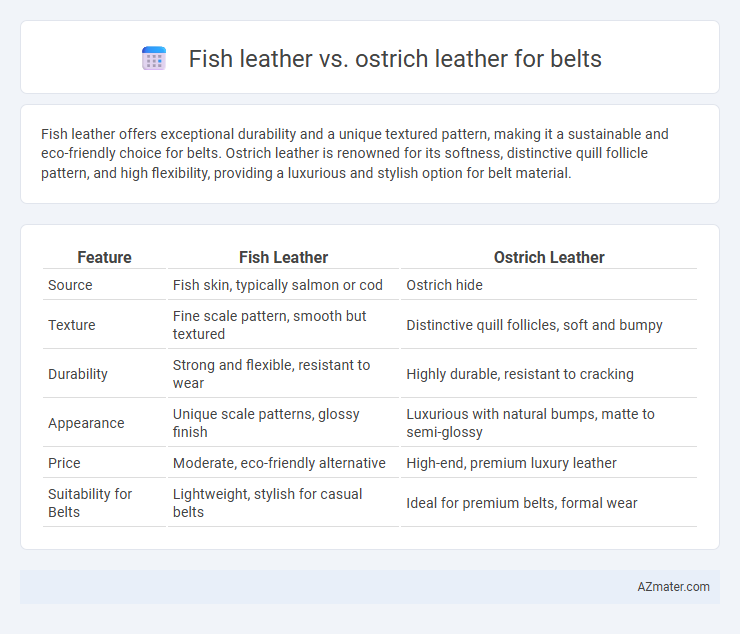Fish leather offers exceptional durability and a unique textured pattern, making it a sustainable and eco-friendly choice for belts. Ostrich leather is renowned for its softness, distinctive quill follicle pattern, and high flexibility, providing a luxurious and stylish option for belt material.
Table of Comparison
| Feature | Fish Leather | Ostrich Leather |
|---|---|---|
| Source | Fish skin, typically salmon or cod | Ostrich hide |
| Texture | Fine scale pattern, smooth but textured | Distinctive quill follicles, soft and bumpy |
| Durability | Strong and flexible, resistant to wear | Highly durable, resistant to cracking |
| Appearance | Unique scale patterns, glossy finish | Luxurious with natural bumps, matte to semi-glossy |
| Price | Moderate, eco-friendly alternative | High-end, premium luxury leather |
| Suitability for Belts | Lightweight, stylish for casual belts | Ideal for premium belts, formal wear |
Introduction to Exotic Leathers: Fish vs Ostrich
Fish leather, derived from species like salmon and cod, offers a unique texture marked by fine scales and remarkable durability, making it a sustainable choice for belt crafting. Ostrich leather, prized for its distinctive quill follicle pattern and exceptional softness, delivers a luxurious and highly flexible material ideal for high-end belts. Both leathers present unique aesthetic and functional qualities, with fish leather emphasizing eco-friendly innovation and ostrich leather embodying traditional luxury.
Overview of Fish Leather: Origins and Processing
Fish leather, primarily derived from species such as salmon, cod, and perch, offers a unique and sustainable alternative to traditional animal hides. The processing involves tanning the thin, scaly hide to enhance durability and flexibility while preserving distinctive natural patterns that make each belt visually striking. This eco-friendly material boasts a high strength-to-weight ratio and resistance to wear, making it an innovative choice for durable and stylish belts.
Ostrich Leather: Unique Characteristics and Sourcing
Ostrich leather is prized for its distinctive quill follicle pattern, offering a unique texture and exceptional durability that surpasses many traditional leathers, including fish leather. Sourced primarily from ostriches raised in South Africa, Argentina, and the United States, this exotic leather undergoes a meticulous tanning process to preserve its softness and strength. Its natural flexibility and resistance to cracking make ostrich leather an ideal choice for high-quality belts, combining luxury with long-lasting wear.
Durability Comparison: Fish Leather vs Ostrich Leather
Fish leather, known for its unique scale patterns, offers exceptional strength and flexibility due to its dense fiber structure, making it highly resistant to wear and tear for belts. Ostrich leather, characterized by its distinctive quill follicles, provides superior durability with natural oils that enhance its resistance to cracking and aging over time. When comparing durability, ostrich leather generally outperforms fish leather in longevity and resistance to environmental factors, while fish leather stands out for its lightweight and water-resistant properties.
Texture and Appearance: Visual Distinctions
Fish leather displays a unique texture characterized by visible scales and natural patterns, offering a distinctive, slightly rough surface ideal for eye-catching belt designs. Ostrich leather is renowned for its pronounced quill follicle bumps, creating a pebbled texture that is both soft and supple, giving belts a luxurious and exotic appearance. Visually, fish leather belts stand out with their iridescent and varied scale patterns, whereas ostrich leather belts provide a more consistent, matte finish with recognizable follicle markings.
Sustainability and Environmental Impact
Fish leather offers a highly sustainable alternative to traditional leathers, as it utilizes byproducts from the fishing industry that would otherwise be discarded, significantly reducing waste and promoting circular economy principles. Ostrich leather, while luxurious and durable, involves raising large birds that require extensive land, water, and feed resources, resulting in a higher environmental footprint compared to fish leather. Choosing fish leather for belts supports eco-friendly fashion by minimizing resource consumption and leveraging renewable materials with lower carbon emissions.
Comfort and Flexibility for Belts
Fish leather offers exceptional softness and flexibility, making it highly comfortable for belts that require frequent bending and wear. Ostrich leather is renowned for its durability and unique texture but tends to be stiffer initially, requiring a break-in period to achieve comparable comfort. The lightweight nature and natural elasticity of fish leather provide superior comfort for everyday belts, while ostrich leather is favored for its robustness and distinct aesthetic appeal.
Pricing and Market Value Analysis
Fish leather belts typically cost between $50 and $150, offering an eco-friendly alternative with unique textures that appeal to niche markets. Ostrich leather belts, priced from $100 to $300, are valued for their distinctive patterns and durability, commanding a higher market value due to their luxury status. Market analysis shows ostrich leather belts retain higher resale value and wider brand recognition, while fish leather is gaining traction in sustainable fashion circles.
Maintenance and Care Requirements
Fish leather belts require gentle cleaning with a damp cloth and should be kept away from excessive moisture to prevent damage, while conditioning with natural oils helps maintain flexibility. Ostrich leather belts are more durable and resilient, needing infrequent conditioning and careful storage to avoid cracking or drying. Both types benefit from avoiding prolonged sun exposure and storing in a cool, dry place to preserve their texture and lifespan.
Conclusion: Choosing the Right Leather for Your Belt
Fish leather offers unique durability and water resistance, making it ideal for belts requiring flexibility and a distinctive texture. Ostrich leather provides unmatched softness and a luxurious grain pattern, perfect for high-end fashion belts that emphasize elegance and comfort. Selecting the right leather depends on whether you prioritize rugged performance or premium aesthetics in your belt choice.

Infographic: Fish leather vs Ostrich leather for Belt
 azmater.com
azmater.com